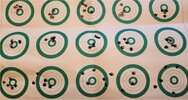A lot of people have been working up loads in this method for a very long time, and it does work
The reality is this:
1) They likely could have chosen any of the charges on the page, randomly, and had the process "work" just as well.
2) They likely missed out on truly improved performance by chasing ONE thing they think "worked better" but didn't actually understand that it wasn't truly better in any way.
In other words, folks pretend this method works because they kinda ended up with a small shooting group (often ignoring how often they say "I don't know what happened, that load was awesome, but it all fell apart," or "it wants to shoot small, but I throw flyers out of the group sometimes," or "all day long if I do my part,"....). What they do NOT do, however, is do further experimentation which proves those OTHER parameter combinations wouldn't work just as well, or even better.
I am genuinely interested in YOUR methodology. How do you generally develop a load? Does it require more or less rounds fired? Why is it better? If it requires to have groups of n>30 to establish a proper statistical distribution, that may just be too time consuming (and primer-consuming!)
My methodology isn't mine - it's a regurgitation of methods I was taught by other shooters and which are commonly known the world over. My personal adoption of these methods does use a VERY low round count, because I don't let myself chase smoke. There's 75 shots on that page - and the OP claims it is a starting point... Were it MY rifle, I'd be done already by 75 rounds - and I wouldn't be looking at these 75 shots and thinking I needed to explore anything else. None achieve the goal stated, and none appear to have a true advantage - a true differentiation - which suggests any of them are better than the other. So I'd ditch that load, either ditch the bullet, ditch the powder, or ditch the barrel - or all of the above.
For my PRS rifles, typically my load development is ~40 rounds for a new bullet and cartridge. 10 to foul, 3 shot groups for 10 weights, and I find regions which are NOT differentiated, and that's my load. They shoot small, they shoot stable, and the load is forgiving. I'm not wasting time (or primers) looking for needles in haystacks, I just pick my piece from the side of the cake which doesn't have a booger on it...
There's nearly-exhaustive science out there which effectively disproves, time and time again, the methods we all used - MYSELF INCLUDED - because we all chased smoke at some point. "A lot of people have been working up loads [with] methods for a very long time" which don't actually work. Folks willingly assume that there is an immediate, irrefutable response for all groups fired to the input variable changes, rather than acknowledging that in reality, they are simply seeing statistically certain probabilities. Shoot 5 groups, ONE will be smaller than the rest, ONE will be larger - do we assume all of our ammo is different if we do that with the same lot of ammo? Or do we accept that it's simple statistical distribution? Accept that rifles just don't shoot the same group size for every group they ever fire? Yes, we realize that group size isn't a fixed result - there is a distribution with standardized error margin. So why then are folks so damned certain that EVERY hole on a page during load development is meaningful - that EVERY change we make in one variable or another is ALWAYS driving a difference on the page?
You do not sound like you lean toward a ladder test either.
One reason "similar POI" focused methods like the Audette Ladder, the Newberry OCW, or Satterlee's rendition of the Audette Velocity curve have been proven to WORK is because they do NOT try to prove groups are "different," but rather
these methods look for indication that groups are NOT different. There's SOME invalidity in the analysis as to the ANOVA between what we assign as "anti-nodes" versus what we believe is in the node (the non-differentiated portion of the ladder), but overall, ladder tests aren't looking for what is different - not looking for the small group among larger groups - it's looking for NON-differentiated results. Proving a null hypothesis is much, much easier than proving a differentiation. So in these methods, we are NOT looking for the ONE small group, and we're NOT chasing our tail by jumping up and down because one random group was coincidentally smaller than the others - but rather, we're looking for a cluster of results with relative insensitivity - where the change didn't appear to make a difference.
Which is really my point in responding to the OP in this thread - he can chase his tail and convince himself that the ONE small group on the page is meaningful, OR he can take heart that no matter what powder charge in that range, that powder and bullet wants to do the same thing, over and over, so he can trust those results.



